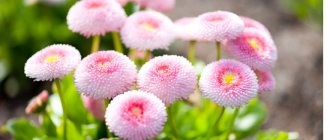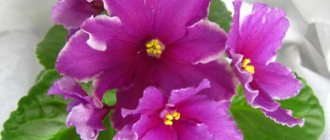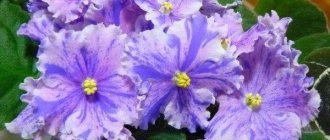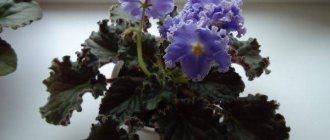Violet Rosemary
The star-shaped, double flowers of the LE Rosemary violet, the photo of which is presented here, will become a luxurious decoration for any collection. The variety, bred by E. Lebetskaya, combines several bright, memorable features. Not only are the notched petals gracefully corrugated, but pink strokes and abundant blue splashes look amazing against a white background. Rosemary violet is a standard-sized plant with a rosette of dark green, toothed leaves.
Features of flowering, growth and reproduction
In favorable conditions it reproduces very quickly and is capable of flowering within 3-5 months after the separation of the stepsons . In rare cases, a full-fledged socket is possible in two months.
When flowering begins, new buds open every 2-3 days. Very quickly it forms a wreath or cap of flowers. Flowering is long and continuous.
It reproduces best by stepsons. They are separated from the mother plant after the formation of the third leaf. Such plants inherit the characteristics of the mother plant, but you must wait until flowering and make sure that it is the chimera that has grown.
If there are leaves on the peduncle, then you can grow a new specimen from this part of the plant. It is planted directly in moist soil. It quickly takes root and begins to develop into a full-fledged plant.
Reproduction by peduncle.
When grown from cuttings, most of the young shoots go to sport. This produces very beautiful specimens.
The peduncles are low, strong, and easily hold the flower.
Violet Bold party girl
The Bold party girl violet obtained by P. Sorano pleases owners with an abundance of double, lilac-pink flowers, reminiscent of the lush frilly skirts of dancers. The shape of the flower is a star, in the center the corolla has a rich fuchsia shade, the edges are lighter and wavy. Blue strokes and blots are scattered across the petals. The standard-sized rosette consists of quilted foliage of simple shape and color.
Due to the susceptibility of Saintpaulia to mutations, sometimes flower growers manage to obtain chimera violets, as in this case from the Bold party girl variety.
Caring for a plant at home
The variety is highly sensitive to soil moisture and plants often die from excessive drought or too much moisture.
Particular attention should be paid to young plants that have not yet grown green mass.
Watering and fertilizing
Watering is carried out only after the top layer of soil dries . If it is a little wet, then you should refrain from moistening, otherwise the roots will rot and the plant will die.
Wick watering can be organized exclusively for adult plants that grow in a pot with a diameter of 9 cm or more. In this case, the violet will independently regulate soil moisture.
Feeding can begin 2 months after transplanting into fresh substrate. During the formation of the rosette, organic fertilizers are applied.
When the violet begins to bud, mineral mixtures with a predominant amount of potassium and phosphorus are used.
It is best to alternate mineral and organic fertilizers. But when the violet blooms, nitrogen is excluded from the fertilizer composition, since the plant begins to actively grow leaves and roots to the detriment of flowering.
Attention! In the second half of September, feeding is stopped. The bush should recover after flowering and prepare for the next season.
Lighting and temperature
It is this variety that depends on the conditions of detention . Excessive heat causes the petals to change color. The white color may disappear completely. This applies not only to the central part of the petals, but also to the border.
The result is a crimson hue with modest purple flecks.
Intentionally increasing or decreasing the temperature to obtain the desired shade is dangerous for the plant itself; it may die . Optimal temperature conditions are from +20 to +24 С. Excessive heat or cold reduces Saintpaulia's resistance to disease.
If pots with violets are located on the north side , then they need to be illuminated using fluorescent or phytolamps. It is best to grow plants on windowsills on the east or west side.
Aggressive lighting on the south side can lead to burns, overheating of the root system and the formation of a large number of side shoots that spoil the appearance of the outlet.
In winter, the Bold Party Girl violet needs to be provided with 10 hours of active light. In summer this time increases to 14 hours. Only in such conditions can active flowering be achieved.
Possible sport option.
Air humidity
It is very important to maintain the required level of humidity. For this variety, 50-60% is enough.
Excessive humidity can lead to the formation of fungal diseases, and if the air is too dry, the leaves will begin to curl and dry out.
Soil selection
When replanting, always use new pots . A coating of salts forms on the surface of old ones, preventing the plant from absorbing nutrients. For the Saintpaulia variety Bold Party Girl, containers with a diameter of 7 to 9 cm are suitable.
The soil should be nutritious and loose . The easiest way is to purchase a ready-made composition at a flower shop. You can add vermiculite or perlite to it. 10% of the total volume of soil is enough.
When prepared independently, they provide vermiculite, sand, leaf and turf soil, and peat . The ratio should be: 1:1:5:3.
Also, a little sphagnum (up to 5%) and wood ash are used as additional components.
Such components disinfect the soil and nourish it with useful substances.
Pruning and hygiene
Violet Bold Party Girl needs certain conditions of maintenance. Deviations from these norms lead to the development of diseases, especially fungi.
Saintpaulia may be affected by:
- fusarium;
- powdery mildew;
- gray mold;
- late blight.
Late blight.
What can lead to the development of the disease:
- insufficient lighting;
- water is too hard and cold for irrigation;
- excessive humidity;
- low temperature or sudden changes;
- draft;
- ignoring violet hygiene.
Treatment will only be successful if it is started at the first sign . All diseased parts are immediately removed, and then the bush is treated with a fungicide. If there are other violets nearby, they also need to be treated. Often a transplant is required, a complete replacement of the pot and soil.
Possible pests:
- scale insects;
- fungus gnats;
- aphid;
- mites;
- Scale insects.
Sticky coatings, suspicious spots and thin cobwebs appear on the leaves. Also a sign of parasites can be curling and drying of leaves. Sometimes insects are so small that they are difficult to spot without a magnifying glass.
Insecticides are used to control parasites . One or two sprays are enough.
Important! Faded flower stalks and dried leaves should be removed in a timely manner.
Reproduction methods
The Bold Party Girl variety is propagated, like all chimeras, by daughter stepsons . This method allows you to guarantee a new plant with characteristic flowering:
- The side shoots are separated from the mother after they form at least three leaves and send out roots. They are separated using an awl;
- Young stepsons are placed in a cassette greenhouse. You can also plant it in a separate pot and place it in a transparent plastic bag.
Stepsons.
Leaf propagation in most cases leads to the formation of a sport . Children bloom in a variety of shades: purple, lilac, blue, pink. It is possible to combine several colors at the same time. Most often, all children from the same leaf bloom differently.
For greater guarantee, the leaf is taken directly near the peduncle and rooted in water or moist soil.
also grow a new plant from a flower stalk . In this case, the chances of getting a chimera are slightly higher than from a regular leaf.
Transplantation and rejuvenation
A healthy and mature specimen is replanted once a year . This can be done in autumn or early spring. If the bush is young, it can be replanted immediately after the end of the first flowering.
The young baby is transplanted twice , in mid-autumn and early winter. With each transplant, use a larger container as the plant grows its root system.
If white mold appears on the surface or the violet has stopped developing, plant buds and perform an emergency transplant . This is also done if diseases or pests are detected.
Violet bold party girl reviews
The plant brings a sea of positivity and pleasure to all owners of violets. The plant has beauty and grace.
Here are some reviews.
Elena: Violet is so airy and light, in one word “girlish”. My flowers are a soft pink color with translucent petals. It seems that if you blow on the bud, it will fly apart.
Sonya: The sports are impressive, they are so diverse that it is impossible to predict what awaits you next time. I got a pair of sports shoes, I’m sure no one else has these. This is incredible!
So, the bold party girl violet is a very delicate and beautiful flower. With proper care, it can please the eye for many years.
Violet bold party girl sport
Breeders do not always manage to transfer hereditary properties to a variety. Sporting occurs when the children differ from the mother plant, hence the name – sport.
Violet bold party girl sport differs from the usual type in the color of the buds. In addition to pink and purple shades, there are lilac, white and lavender.
Thanks to sporting, you can develop a flower that is not similar to any other option.
Reproduction methods
There are several options:
- children;
- stepchildren;
- leaf with stem.
In the first case, the baby is cut off during the flowering period.
In the second case, you need to remove the rosette from the flowerpot and use a sharp knife to cut off the side stepsons, which must have their own root and a couple of leaves. The stepsons are sent into containers and covered with film for a greenhouse effect.
Third option. Take a cutting, put it in liquid with activated carbon, after 14 days roots will appear. Now it is transplanted into the soil, watered and covered with film until new shoots form.
Disease prevention and pest protection
Violation of recommendations for the maintenance and care of the plant leads to fungal diseases: late blight, gray mold, fusarium, powdery mildew.
The development of diseases is promoted by:
- waterlogging of the soil;
- watering with cold or hard water;
- keeping at low temperatures;
- violation of plant hygiene;
- lack of lighting;
- drafts and temperature changes.
Treatment of violets must begin when the first signs of the disease appear. All leaves affected by fungi must be cut off, and then the plant must be sprayed with a fungicide (Fundazol, Topaz, copper sulfate, Oksikhom).
Insect pests pose a great danger to violets:
- mites;
- aphid;
- scale insects;
- scale insects, false scale insects;
- fungus gnats.
The appearance of pests on the plant is indicated by a sticky or ash-gray coating and cobwebs on the leaves, curling and wilting of the leaves, spots on the upper or lower side. The pest is destroyed by spraying with insecticides Aktara, Aktellik, Fufanon, Alatar, etc.
Reproduction methods
The violet variety "Bold party girl" is best propagated by children.
It is recommended to propagate the violet "Bold party girl" by stepchildren. This is the only way to be guaranteed to obtain a specimen with flowering characteristic of the variety. Daughter rosettes are separated from the mother rosette at the peak of flowering. The procedure does not harm the plant, and even benefits it, increasing the duration of flowering.
The mother rosette is carefully removed from the pot and the side stepsons are separated with an awl. Each daughter rosette must have its own roots and at least three leaves. Stepchildren are planted in separate pots and covered with a transparent cap to create greenhouse conditions.
The "Bold party girl" violet can also be propagated by leaf cuttings, but in this case, most of the grown children go into sports. The sports obtained from this violet are also incredibly beautiful. It is impossible to guess what color the plant obtained from a cutting will bloom. Children bloom as they please, in a variety of colors: blue, lilac, pink, purple shades of the most incredible tints.
The leaf for rooting is taken directly under the peduncle and placed in a glass of water with an activated carbon tablet added. After the formation of roots 1-1.5 centimeters long on the cuttings, it is planted in a cup with a soil-sand mixture.
[adsp-pro-7]
Alternatively, the cuttings can be immediately rooted in a mixture of soil, vermiculite and sand. To do this, take plastic cups, fill it halfway with drainage (expanded clay or pieces of foam), then pour in a mixture of soil, vermiculite and sand in equal quantities. The leaf stalk is buried 1.5 centimeters and covered with a transparent cap.
The Bold party girl variety is very early, so the children bloom 6-8 months after the start of independent life.
Violets grown from a rooted leaf can have an unpredictable color.
Rules of care
Watering plays a special role; both dry soil and waterlogging are dangerous. Several methods are used:
- wick;
- regular soil watering;
- pouring water into the pan.
Water is poured into the tray and pots with violets are placed on top, after 30 minutes the pots are pulled out, the water is removed to place the pots in a dry place.
The best option is wick. To do this, take a synthetic cord, one edge is brought out through the bottom, the other end of the cord is lowered into the ground in the center of the pot and sprinkled. The flowerpot is placed in a container with water, where the outer cord is lowered. This system is similar to drip irrigation.
Learn more about the rules for caring for violets in the video:
How to replant, what pot and soil to choose
There are two types of transplantation:
- emergency;
- planned.
Rules for planned transplantation:
- It is carried out in early spring or mid-autumn, after the flowers fall.
- All children are removed, the soil and the pot are replaced with a larger one.
An emergency procedure is performed in the following cases:
- growth stops;
- a white coating has formed on the ground;
- there are no buds.
The diameter of the pot is from 7 to 10 cm for a young plant and 12-13 cm for an adult. The flowerpot should be low but wide. Plastic containers are ideal as they hold moisture well.
The soil should be loose, special for violets. Expanded clay is used as drainage.
To make the soil lighter, add ten percent perlite and vermiculite, and a little wood ash for disinfection.
Feeding
The first feeding is carried out in April, using mineral and organic substances. The second type of fertilizer is especially necessary when foliage is forming.
The next feeding is carried out during the formation of inflorescences. In this case, potassium and phosphorus are taken; the use of nitrogen is contraindicated.
The last fertilizers are introduced at the beginning of autumn (mid-September), using funds for this crop.
Subsequently, a dormant period begins, and the plant does not need feeding or fertilizing.
Reviews
Valeria, Kursk. “Sports of this variety are like fingerprints. There are simply no two alike in nature. It seems that these are completely different varieties. All sports give different shades, but the flowers are always large and lush.”
Anatoly, St. Petersburg. “To get a chimera, it is best to take daughter stepsons. It is also possible to grow from a peduncle. If, in addition to the buds, it has produced a couple of small leaves, then it can be successfully planted in the soil. Most often, chimeras grow.”
Nadezhda, Moscow region. “The violet pleases with its early and abundant flowering. The flowering period lasts a very long time. Each time it blooms in a new way. The saturation of flowers depends on the conditions and time of year. The variety is unpretentious and easy to grow.”
Conditions of detention
There are several points to consider:
- temperature regime. The norm is considered to be from 20 to 24 degrees (at high temperatures the color becomes dark, at low temperatures it becomes pale, and the flower may die);
- the need for diffused but bright light (for this, the flowerpot must be placed on a saucer on the north-west, west or north-east side);
- if the windows face only north, additional lighting is required; if they face south, they should be darkened and protected from direct ultraviolet rays;
- Humidity levels should range from fifty to sixty percent.
Compliance with all these nuances will create optimal conditions for violets.
Violet bold party girl photo and description of the variety
Plant characteristics:
- The flowers are double and look like fluffy skirts with a frill.
- The petals are pink and lilac in color, sometimes have purple spots or stripes; in the central part the color is more saturated, the border along the edge is light. Spots and stripes increase in number throughout life.
- The culture is inclined towards sports.
- The diameter of the inflorescences is six to seven centimeters. At the same time, many flower stalks are formed as a wreath or cap.
- Flowering is long, the shoots are strong, even with abundant flowering they do not bend from weight.
- The leaves are arranged neatly, formed symmetrically, the rosette is of normal size. Green color.
- The root system is expanding
- Short in stature.
With proper care, the violet will delight the owner with beautiful buds for many years in a row.
More details about the bold party girl violet in the video:











